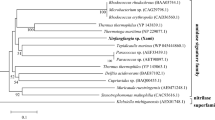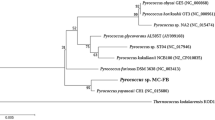Abstract
A thermostable amidase produced by Geobacillus subterraneus RL-2a was purified to homogeneity, with a yield of 9.54 % and a specific activity of 48.66 U mg−1. The molecular weight of the native enzyme was estimated to be 111 kDa. The amidase of G. subterraneus RL-2a is constitutive in nature, active at a broad range of pH (4.5–11.5) and temperature (40–90 °C) and has a half-life of 5 h and 54 min at 70 °C. Inhibition of enzyme activity was observed in the presence of metal ions, such as Co2+, Hg2+, Cu2+, Ni2+, and thiol reagents. The presence of mid-chain aliphatic and amino acid amides enhances the enzymatic activity. The acyl transferase activity was detected with propionamide, butyramide and nicotinamide. The enzyme showed moderate stability toward toluene, carbon tetrachloride, benzene, ethylene glycol except acetone, ethanol, butanol, propanol and dimethyl sulfoxide. The K m and V max of the purified amidase with nicotinamide were 6.02 ± 0.56 mM and 132.6 ± 4.4 μmol min−1 mg−1 protein by analyzing Michaelis–Menten kinetics. The results of MALDI-TOF analysis indicated that this amidase has homology with the amidase of Geobacillus sp. C56-T3 (gi|297530427). It is the first reported wide-spectrum thermostable amidase from a thermophilic G. subterraneus.




Similar content being viewed by others
References
Asano Y, Lubbehusen TL (2000) Enzymes acting on peptides containing d-amino acid. J Biosci Bioeng 89:295–306
Asano Y, Tachibana M, Tani Y, Yamada H (1982) Purification and characterization of amidase which participates in nitrile degradation. Agric Biol Chem 46:1175–1181
Baek DH, Song JJ, Lee SG, Kwon SJ, Asano Y, Sung MH (2003) New thermostable d-methionine amidase from Brevibacillus borstelensis BCS-1 and its application for d-phenylalanine production. Enzyme Microb Technol 32:131–139
Banerjee A, Sharma R, Banerjee UC (2002) The nitrile degrading enzymes: current status and future prospects. Appl Microbiol Biotechnol 60:33–44
Bradford MM (1976) A rapid and sensitive method for the quantitation of microgram quantities of protein utilizing the principle of protein dye binding. Anal Biochem 72:248–254
Brammer WJ, Clarke PH (1964) Induction and repression of Pseudomonas aeruginosa amidase. J Gen Microbiol 37:307–319
Cameron RA, Sayed M, Cowan DA (2005) Molecular analysis of the nitrile catabolism operon of the thermophile Geoacillus pallidus RAPc8B. Biochim Biophys Acta 1725:35–46
Chebrou H, Bigey F, Arnaud A, Galzy P (1996) Study of the amidase signature group. Biochim Biophys Acta 1298:285–293
Ciskanik L, Wilczek JM, Fallon RD (1995) Purification and characterization of an enantioselective amidase from Pseudomonas chlororaphis B23. Appl Environ Microbiol 61:998–1003
Cowan D, Fernandez-Lafuente R (2011) Enhancing the functional properties of thermophilic enzymes by chemical modification and immobilization. Enzyme Microb Technol 49:326–346
d’Abusco SA, Ammendola S, Scandurra R, Politi L (2001) Molecular and biochemical characterization of the recombinant amidase from hyperthermophilic archaeon Sulfolobus solfataricus. Extremophiles 5:183–192
Egorova KV, Trauthwein H, Antranikian G (2002) A rapid and sensitive method for the detection of amidases in polyacrylamide gels and agar plates. German patent 10233686.5
Egorova K, Trauthwein H, Verseck S, Antranikian G (2004) Purification and properties of an enantioselective and thermoactive amidase from the thermophilic actinomycete Pseudonocardia thermophila. Appl Microbiol Biotechnol 65:38–45
Fawcett JK, Scott JE (1960) A rapid and precise method for the determination of urea. J Clin Pathol 13:156–159
Fournand D, Arnaud A (2001) Aliphatic and enantioselective amidases: from hydrolysis to acyl transfer activity. J Appl Microbiol 91:381–393
Hermes H, Tandler RF, Sonke T, Dijkhuizen L, Meijer EM (1994) Purification and characterization of an l-amino amidase from Mycobacterium neoaurum ATCC 25795. Appl Environ Microbiol 1:153–159
Hirrlinger B, Stolz A, Knackmuss HJ (1996) Purification and properties of an amidase from Rhodococcus erythropolis MP50 which enantioselectively hydrolyzes 2-arylpropionamides. J Bacteriol 178:3501–3507
Karmali A, Tata R, Brown PR (2000) Substitution of Glu-59 by Val in amidase from Pseudomonas aeruginosa results in a catalytically inactive enzyme. Mol Biotechnol 16:5–16
Kim S, Oriel P (2000) Cloning and expression of the nitrile hydratase and amidase genes from Bacillus sp. BR449 into Escherichia coli. Enzyme Microb Technol 27:492–501
Kobayashi M, Komeda H, Nagasawa T, Yamada H, Shimizu S (1993) Occurrence of amidases in the industrial microbe Rhodococcus rhodochrous J1. Biosci Biotechnol Biochem 57:1949–1950
Komeda H, Asano Y (2000) Gene cloning, nucleotide sequencing, and purification and characterization of the d-stereospecific amino-acid amidase from Ochrobactrum anthropi SV3. Eur J Biochem 267:2028–2035
Komeda H, Hariyama N, Asano Y (2006) l-Stereoselective amino acid amidase with broad substrate specificity from Brevundimonas diminuta: characterization of a new member of the leucine aminopeptidase family. Appl Microbiol Biotechnol 70:412–421
Maestracci M, Thiery A, Arnaud A, Glazy P (1980) A study of the mechanism of the reaction catalysed by the amidase of Brevibacterium sp. R312. Agric Biol Chem 50:2237–2241
Makhongela HS, Glowacka AE, Agarkar VB, Sewell T, Weber B, Cameron RA, Cowan DA, Burton SG (2007) A novel thermostable nitrilase superfamily amidase from Geobacillus pallidus showing acyl transfer activity. Appl Microbiol Biotechnol 75:801–811
Mayaux J, Cerebelaud E, Soubrier F, Faucher D, Petre D (1990) Purification, cloning, and primary structure of an enantiomer-selective amidase from Brevibacterium sp. strain R312: structural evidence for genetic coupling with nitrile hydratase. J Bacteriol 172:6764–6773
Mayaux J, Cerbelaud E, Soubrier F, Yeh P, Blanche F, Petre D (1991) Purification, cloning, and primary structure of a new enantiomer-selective amidase from a Rhodococcus strain: structural evidence for a conserved genetic coupling with nitrile hydratase. J Bacteriol 173:6694–6704
Mylerova V, Martinkova L (2003) Synthetic applications of nitrile-converting enzymes. Curr Org Chem 7:1–17
Nawaz MS, Franklin W, Cerniglia CE, Campbell WL, Heinze TM (1991) Metabolism of acrylonitrile by Klebsiella pneumoniae. Arch Microbiol 156:231–238
Nawaz M, Khan AA, Seng JE, Leakey JE, Siitonen PH, Cerniglia CE (1994) Purification and characterization of an amidase from an acrylamide-degrading Rhodococcus sp. Appl Environ Microbiol 60:3343–3348
Nawaz MS, Khan AA, Bhattacharayya D, Siitonen PH, Cerniglia CE (1996) Physical, biochemical and immunological characterization of a thermostable amidase from Klebsiella pneumoniae NCTR 1. J Bacteriol 178:2397–2401
Sharma M, Sharma NN, Bhalla TC (2012) Biotransformation of acetamide to acetohydroxamic acid at bench scale using acyl transferase activity of amidase of Geobacillus pallidus BTP-5x MTCC 9225. Ind J Microbiol 52:76–82
Sharma M, Sharma NN, Bhalla TC (2013) Purification studies on a thermo-active amidase of Geobacillus pallidus BTP-5x MTCC 9225 isolated from thermal springs of Tatapani (Himachal Pradesh). Appl Biochem Biotechnol 169:1–14
Silman N, Carver MA, Jones CW (1991) Directed evolution of amidase in Methylophilus methylotrophus: purification and properties of amidases from wild-type and mutant strain. J Gen Microbiol 13:169–178
Skouloubris S, Labigne A, De Reuse H (1997) Identification and characterization of an aliphatic amidase in Helicobacter pylori. Mol Microbiol 25:989–998
Stelkes-Ritter U, Wyzgol K, Kula MR (1995) Purification and characterization of a newly screened microbial peptide amidase. Appl Microbiol Biotechnol 44:393–398
Suzuki Y, Ohta H (2006) Identification of a thermostable and enantioselective amidase from the thermoacidophilic archaeon Sulfolobus tokodaii strain 7. Protein Expr Purif 45:368–373
Takesawa Y, Cowan D, Bannerjea J, Hoare M (1990) Heat induced precipitation of cell homogenates: an investigation of the recovery of thermostable proteins. Enzyme Microb Technol 12:184–189
Trott S, Bauer R, Knackmuss HJ, Stolz A (2001) Genetic and biochemical characterization of an enantioselective amidase from Agrobacterium tumefaciens strain d3. Microbiology 147:1815–1824
Xue Z, Chao Y, Wang D, Wang M, Qian S (2011) Overexpression of a recombinant amidase in a complex auto-inducing culture: purification, biochemical characterization, and regio- and stereoselectivity. J Ind Microbiol Biotechnol 38:1931–1938
Author information
Authors and Affiliations
Corresponding author
Additional information
Communicated by H. Atomi.
Rights and permissions
About this article
Cite this article
Mehta, P.K., Bhatia, S.K., Bhatia, R.K. et al. Purification and characterization of a novel thermo-active amidase from Geobacillus subterraneus RL-2a. Extremophiles 17, 637–648 (2013). https://doi.org/10.1007/s00792-013-0547-3
Received:
Accepted:
Published:
Issue Date:
DOI: https://doi.org/10.1007/s00792-013-0547-3




